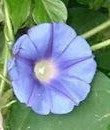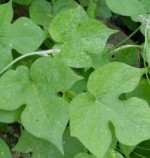 A native of tropical areas of South America ivyleaf morning glory has spread to North America where it is now found from Arizona to Florida, north to North Dakota and Ontario. It is an annual climbing vine that grows equally well on shrubs or on the ground and is a common weed in gardens and crops in eastern United States. It prefers full sun and moist well-drained soil but tolerates less.
A native of tropical areas of South America ivyleaf morning glory has spread to North America where it is now found from Arizona to Florida, north to North Dakota and Ontario. It is an annual climbing vine that grows equally well on shrubs or on the ground and is a common weed in gardens and crops in eastern United States. It prefers full sun and moist well-drained soil but tolerates less.

 Description: Plants emerge in the spring and grow into long twining vines up to ten feet long. The stems are covered with erect hairs and carry alternate leaves that have three lobes and resemble those of English ivy. The leaves are 2-5” long and are also hairy. From mid-summer to fall funnel-shaped flowers 1-2 inches long are produced that bloom only in the morning. The flowers are blue, purple or white and have dense straight hairs around their base. The fruits are round brown capsules with three compartments and contain 4-6 seeds. The seeds are dispersed from summer to fall and usually germinate the following spring but can remain in the soil for many years. The root is a shallow, slender taproot.
Description: Plants emerge in the spring and grow into long twining vines up to ten feet long. The stems are covered with erect hairs and carry alternate leaves that have three lobes and resemble those of English ivy. The leaves are 2-5” long and are also hairy. From mid-summer to fall funnel-shaped flowers 1-2 inches long are produced that bloom only in the morning. The flowers are blue, purple or white and have dense straight hairs around their base. The fruits are round brown capsules with three compartments and contain 4-6 seeds. The seeds are dispersed from summer to fall and usually germinate the following spring but can remain in the soil for many years. The root is a shallow, slender taproot.

 Control: Ivyleaf morning glory is best controlled by hand pulling because the taproot is small and will not resprout if left in the soil. Removing the flowers before seed formation is essential to control because the vine is an annual and relies on seed for continued presence in the garden. A pre-emergent herbicide reduces seed germination and both selective and non-selective herbicides are effective on plants.
Control: Ivyleaf morning glory is best controlled by hand pulling because the taproot is small and will not resprout if left in the soil. Removing the flowers before seed formation is essential to control because the vine is an annual and relies on seed for continued presence in the garden. A pre-emergent herbicide reduces seed germination and both selective and non-selective herbicides are effective on plants.